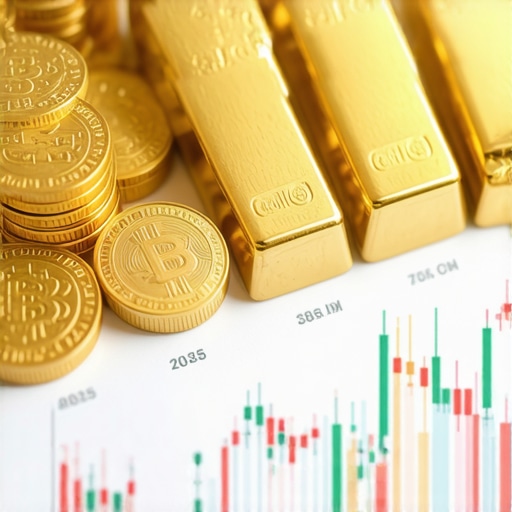Understanding Gold Investment Types for Beginners
Investing in gold can be an excellent way to diversify your portfolio and safeguard your wealth against economic uncertainties. As a new investor, you may find the variety of gold investment types overwhelming. This guide aims to simplify the decision-making process by exploring the most common types of gold investments, providing you with the knowledge necessary to make informed choices.
Different Types of Gold Investments
When considering gold investments, it’s essential to understand the various forms they can take. Here’s a breakdown of the most popular options:
1. Physical Gold: Bars and Coins
Investing in physical gold typically involves purchasing gold bars or coins. This tangible asset offers the security of owning a physical item that has intrinsic value. Gold bars are often available in various weights, while coins may be minted by governments and hold numismatic value in addition to their gold content. For beginners, investing in gold coins can be a more accessible entry point.
2. Gold ETFs and Mutual Funds
Exchange-Traded Funds (ETFs) and mutual funds that focus on gold investments provide an alternative for those who prefer not to manage physical gold. Gold ETFs typically track the price of gold and can be traded on stock exchanges like shares. This method allows for easier buying and selling while avoiding storage issues. If you’re interested in comparing gold ETFs and mutual funds, consider factors such as fees, performance, and the underlying assets.
3. Gold Mining Stocks
Investing in gold mining stocks can offer exposure to the gold market without directly buying physical gold. Shares of companies engaged in gold mining can provide significant returns, especially in a rising gold price environment. However, it’s crucial to note that these stocks can be more volatile than the price of gold itself. Understanding the fundamentals of gold mining stocks is vital to gauge the potential risks and rewards.
4. Gold Futures and Options
For experienced investors, gold futures and options can be appealing as they allow for speculation on the future price of gold. Futures contracts obligate the buyer to purchase gold at a predetermined price on a specific future date. Options, on the other hand, provide the right, but not the obligation, to buy or sell gold at a certain price before the contract expires. Engaging in these types of investments requires a thorough understanding of market trends and trading strategies. For more on effective trading techniques, check out effective gold trading techniques.
5. Gold IRAs
Gold Individual Retirement Accounts (IRAs) are specialized retirement accounts that allow you to hold physical gold as part of your retirement portfolio. This investment type not only diversifies your assets but also provides potential tax benefits. If you’re considering a Gold IRA, it’s essential to understand the rules and regulations governing these accounts. A complete overview can be found in What is a Gold IRA?
As you explore the various gold investment types, it’s crucial to assess your financial goals, risk tolerance, and market conditions. Each investment type has its advantages and potential pitfalls, making it imperative to conduct thorough research and seek guidance where necessary. The right investment strategy can enhance your portfolio and provide a hedge against inflation and market volatility, setting the foundation for a successful investment journey in gold.
Advanced Gold Investment Options to Consider
As you delve deeper into the world of gold investments, it’s important to explore advanced options that can enhance your portfolio further. These investment types often require a more nuanced understanding of the market but can offer unique advantages.
1. Collectible Gold Coins
Collectible gold coins, often referred to as numismatic coins, can be an intriguing addition to your investment strategy. Unlike standard gold coins, collectible coins derive their value from rarity and demand, which can sometimes lead to higher returns. However, investing in collectibles requires knowledge about the coin market and careful assessment of authenticity and condition. For those looking to invest wisely, understanding gold coins can provide insight into potential opportunities.
2. Gold Certificates
Gold certificates represent ownership of gold without requiring physical possession. These documents can be an effective way to invest in gold while avoiding storage concerns associated with physical gold. However, it is important to evaluate the credibility of the issuing authority and the terms of ownership. Investors should consider the risks and benefits associated with holding a gold certificate, including market volatility and the issuer’s reliability.
3. Gold Royalties and Streaming Companies
Investing in gold royalty and streaming companies is another sophisticated way to gain exposure to the gold market. These companies finance mining operations in exchange for a percentage of the revenue or production. This model can provide investors with a steady income stream and lower risk compared to direct investments in mining stocks. To understand the dynamics of this investment strategy, it’s beneficial to read evaluating gold stocks and explore how these companies operate within the market.
4. Gold Options Trading
For those with a strong grasp of market trends, gold options trading allows for speculation on future price movements without the obligation to buy physical gold. This strategy can be risky but also offers the potential for high rewards if executed correctly. Learning about effective trading techniques can enhance your ability to navigate the complexities of options trading.
5. Investing in Gold via Cryptocurrency
In recent years, the advent of cryptocurrency has introduced new avenues for gold investment. Certain cryptocurrencies are backed by gold, offering a digital alternative to traditional gold investing. This method allows for increased liquidity and can appeal to tech-savvy investors. However, it’s essential to thoroughly research the cryptocurrency market and understand the risks involved in this innovative approach.
As you consider these advanced options, it’s critical to align your investment choices with your financial goals and risk tolerance. Each type of investment offers unique advantages and challenges, which can significantly impact your overall investment strategy. For instance, while gold royalties can provide a steady income, collectible coins may require a more hands-on approach to ensure value appreciation.
Before making any significant investment decisions, it’s advisable to conduct thorough research and, if necessary, consult with financial advisors who specialize in precious metals. Understanding gold demand trends can provide valuable insights into market movements and potential investment opportunities.
Exploring Gold Investment Strategies for the Modern Investor
As the landscape of gold investments evolves, understanding the advanced strategies becomes crucial for those looking to maximize their returns. These strategies not only require a deeper knowledge of the market but also an awareness of the potential risks and rewards involved.
1. Gold Streaming Agreements
Gold streaming agreements represent a unique investment approach where investors provide upfront capital to gold mining companies in exchange for future production at a reduced cost. This method allows investors to gain exposure to gold prices without directly investing in mining stocks. By analyzing gold stocks and their performance, you can identify lucrative streaming opportunities that may yield significant returns.
2. Gold ETFs: A Tactical Approach
While gold ETFs are commonly known, employing a tactical approach can enhance your investment strategy. For instance, actively managing your positions based on market trends can allow you to capitalize on short-term price movements. Understanding the nuances of different gold ETFs and their underlying assets will enable you to make informed decisions that align with your investment goals.
3. The Role of Gold in Portfolio Diversification
Gold plays a pivotal role in portfolio diversification, acting as a hedge against inflation and market volatility. By incorporating gold into your investment strategy, you can mitigate risks associated with traditional assets like stocks and bonds. To further understand how gold can safeguard your investments, explore the insights in safeguarding wealth with gold.
4. Understanding Gold Demand Trends
Keeping abreast of gold demand trends is essential for any serious investor. Factors such as global economic conditions, interest rates, and geopolitical tensions can significantly influence gold prices. By analyzing these demand trends, you can make better predictions about future price movements and adjust your investment strategy accordingly. For a deeper dive into current trends, refer to understanding gold demand trends.
5. Investing in Gold through Cryptocurrency
The rise of cryptocurrency has opened new avenues for gold investment, with certain digital currencies being backed by physical gold. This innovative approach combines the advantages of cryptocurrency, such as increased liquidity and accessibility, with the stability of gold. However, thorough research into the specific cryptocurrencies and their backing is essential to navigate this emerging market effectively. Consider reading about investing in gold via cryptocurrency for additional insights.
Leveraging Advanced Trading Techniques
As you venture into advanced gold trading, employing effective trading techniques is vital for success. Understanding the market dynamics and developing a solid trading plan can enhance your ability to capitalize on opportunities.
1. Technical Analysis for Gold Trading
Utilizing technical analysis can provide traders with insights into market behavior, enabling them to make informed decisions. By studying price charts and key indicators, investors can identify trends and potential reversal points. For a comprehensive overview of trading strategies, check out mastering gold trading techniques.
2. Risk Management Strategies
Implementing effective risk management strategies is crucial for protecting your investments. This includes setting stop-loss orders, diversifying your portfolio, and avoiding over-leveraging. By managing risks, you can safeguard your capital while pursuing profitable opportunities in the gold market.
As you navigate these advanced strategies, continuously educating yourself about market trends and investment options will be key to enhancing your gold investment journey. The world of gold investing is rich with opportunities, and the right knowledge can lead to successful outcomes.
Understanding the Importance of Gold Investment Strategies
In today’s ever-changing financial landscape, having a solid gold investment strategy is essential for maximizing returns and minimizing risks. As you continue your journey into the world of gold investing, it’s crucial to explore various strategies that can help you navigate the complexities of this precious metal market.
1. Diversification: A Key Strategy
Diversifying your gold investments is vital to mitigate risks. By spreading your investments across different types of gold assets—such as gold bars, gold coins, gold mining stocks, and ETFs—you can balance potential gains against market fluctuations. This approach reduces your exposure to any single asset’s volatility and enhances your overall investment stability.
2. Timing the Market: Key Considerations
Understanding when to enter or exit the gold market can significantly impact your investment returns. Monitoring market trends, economic indicators, and geopolitical events can provide insights into optimal buying and selling points. For a more comprehensive understanding of current market dynamics, refer to our guide on gold market trends.
3. Utilizing Dollar-Cost Averaging
One effective strategy for investing in gold is to use dollar-cost averaging (DCA). By regularly investing a fixed amount into gold—regardless of its price—you can reduce the impact of market volatility. This approach allows you to accumulate gold over time and can lead to lower average costs per ounce.
4. Keeping Abreast of Global Economic Factors
Global economic conditions play a significant role in influencing gold prices. Factors such as inflation rates, currency strength, and interest rates can impact gold’s value. Staying informed about these economic indicators will help you make informed decisions about your investments. For insights into key economic influences, consider reading what drives gold prices.
5. Understanding Gold Demand Trends
Keeping track of gold demand trends is essential for anticipating price movements. Factors such as jewelry demand, investment trends, and central bank purchases can significantly affect gold prices. Analyzing these trends can provide valuable insights into potential investment opportunities. To gain a deeper understanding of current and future demand, explore our article on exploring gold demand trends.
Effective Risk Management in Gold Investments
Risk management is a critical component of any investment strategy, including gold. Here are some effective practices to minimize risks associated with gold investing:
1. Setting Stop-Loss Orders
Implementing stop-loss orders can protect your investments from significant losses. By setting a predetermined price at which your gold assets will be sold, you can limit potential losses and safeguard your capital.
2. Regular Portfolio Review
Reviewing your gold investment portfolio regularly ensures that you stay aligned with your financial goals. Adjusting your strategy based on performance, market conditions, and personal circumstances can help you maintain a robust investment approach.
3. Seeking Professional Guidance
If you’re uncertain about your investment choices, consider consulting with financial advisors who specialize in gold. They can provide valuable insights tailored to your specific situation, helping you navigate the complexities of gold investments.
By implementing these strategies and maintaining an informed perspective on the gold market, you can enhance your investment journey and work towards achieving your financial goals.
Frequently Asked Questions about Gold Investments
1. What are the benefits of investing in gold?
Investing in gold offers several advantages, including a hedge against inflation, portfolio diversification, and a safe haven during economic downturns. Gold has historically maintained its value and can provide stability in uncertain market conditions.
2. How can I start investing in gold as a beginner?
To start investing in gold, consider your investment goals and risk tolerance. You can begin by purchasing physical gold, such as coins or bars, or explore gold ETFs and mutual funds for a more hands-off approach. Researching different investment types and seeking advice from financial experts can also be beneficial.
3. Is it better to invest in physical gold or gold stocks?
The choice between physical gold and gold stocks depends on your investment strategy. Physical gold offers tangible ownership and security, while gold stocks can provide greater liquidity and potential for higher returns. Assessing your risk tolerance and investment goals will help you make the right decision.
4. What is a Gold IRA and how does it work?
A Gold IRA is a type of individual retirement account that allows you to invest in physical gold and other precious metals. This investment can offer tax advantages and diversification for your retirement portfolio. However, it is essential to follow IRS regulations regarding the types of gold that can be held within the account.
5. What are gold ETFs and how do they function?
Gold ETFs (Exchange-Traded Funds) are investment funds that track the price of gold. They are traded on stock exchanges like regular stocks, providing an accessible way to invest in gold without the need to store physical bullion. Investors can buy and sell shares of gold ETFs throughout the trading day.
6. How often should I review my gold investment portfolio?
Regular reviews of your gold investment portfolio are crucial for aligning with your financial goals and market conditions. It’s advisable to assess your portfolio at least annually or whenever significant market changes occur, ensuring that your investments remain on track.
7. What risks are associated with gold investing?
Gold investing carries various risks, including price volatility, market speculation, and potential liquidity issues. Additionally, physical gold requires secure storage and insurance. Understanding these risks and implementing effective risk management strategies can help mitigate potential losses.
8. Can I invest in gold through cryptocurrency?
Yes, certain cryptocurrencies are backed by gold, offering innovative ways to invest in both assets. This method provides increased liquidity and accessibility but requires thorough research to understand the specific cryptocurrencies and their backing mechanisms.
9. How do geopolitical events affect gold prices?
Geopolitical tensions and events can significantly influence gold prices. During times of uncertainty or conflict, investors often flock to gold as a safe-haven asset, driving up its demand and price. Monitoring global events can help investors anticipate potential price movements.
10. What resources can help me learn more about gold investing?
Several reputable resources can enhance your knowledge of gold investing, including financial news websites, investment blogs, and books dedicated to precious metals. Websites like the World Gold Council and various financial advisory platforms offer comprehensive insights and data on gold markets.
Authority Resources for Gold Investment Insights
To deepen your understanding of gold investments, consider exploring these trusted resources:
- World Gold Council – Provides insights, research, and data on gold markets and trends.
- Investopedia – Offers educational articles and guides on gold investing and related financial concepts.
- Kitco – A leading source for precious metals market information, pricing, and news.
- Bloomberg Markets – Delivers up-to-date financial news, including gold market analysis.
- Forbes – Features articles discussing the value of gold investments and market outlooks.
By leveraging these resources, you can stay informed about market trends, investment strategies, and expert opinions, setting the stage for a successful gold investment journey.
Conclusion
In conclusion, investing in gold can be a rewarding venture when approached with the right strategies and knowledge. From understanding various investment types to implementing effective risk management techniques, this comprehensive guide has covered essential aspects of gold investments. By staying informed about market trends and leveraging trusted resources, you can navigate the complexities of the gold market and enhance your investment portfolio. Remember, the key to successful gold investing lies in continuous learning and aligning your investment choices with your financial goals.









